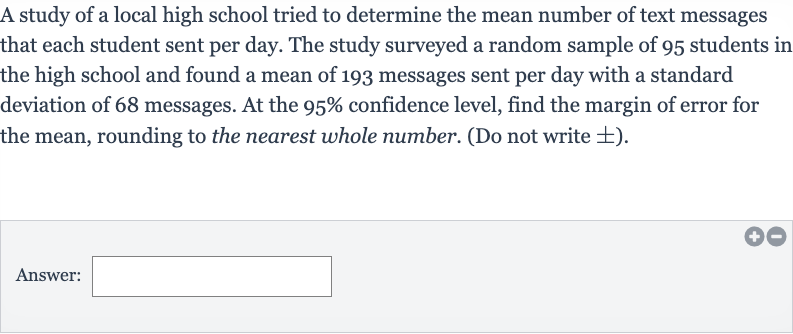AI tutor
Welcome to Bytelearn!
Let’s check out your problem:

A study of a local high school tried to determine the mean number of text messages that each student sent per day. The study surveyed a random sample of students in the high school and found a mean of messages sent per day with a standard deviation of messages. At the confidence level, find the margin of error for the mean, rounding to the nearest whole number. (Do not write ).Answer:
Full solution
Q. A study of a local high school tried to determine the mean number of text messages that each student sent per day. The study surveyed a random sample of students in the high school and found a mean of messages sent per day with a standard deviation of messages. At the confidence level, find the margin of error for the mean, rounding to the nearest whole number. (Do not write ).Answer:
- Define Margin of Error Formula: To find the margin of error at the confidence level, we need to use the formula for the margin of error (ME) in a sample mean, which is , where is the z-score corresponding to the confidence level, is the standard deviation, and is the sample size.
- Find Z-Score for % Confidence: First, we need to find the z-score that corresponds to the confidence level. For a confidence interval, the z-score is typically . This value can be found in standard z-score tables or by using a statistical calculator.
- Calculate Margin of Error: Next, we plug in the values into the margin of error formula. We have the standard deviation () as messages and the sample size () as students.
- Calculate Square Root of Sample Size: Now, we calculate the denominator, which is the square root of the sample size .
- Divide Standard Deviation by Square Root: We then divide the standard deviation by the square root of the sample size.
- Multiply Result by Z-Score: Finally, we multiply this result by the z-score to find the margin of error.
- Round Margin of Error: Since we need to round to the nearest whole number, the margin of error rounded to the nearest whole number is .
More problems from Interpret confidence intervals for population means
QuestionGet tutor help
QuestionGet tutor help
QuestionGet tutor help
QuestionGet tutor help
QuestionGet tutor help
QuestionGet tutor help
QuestionGet tutor help
